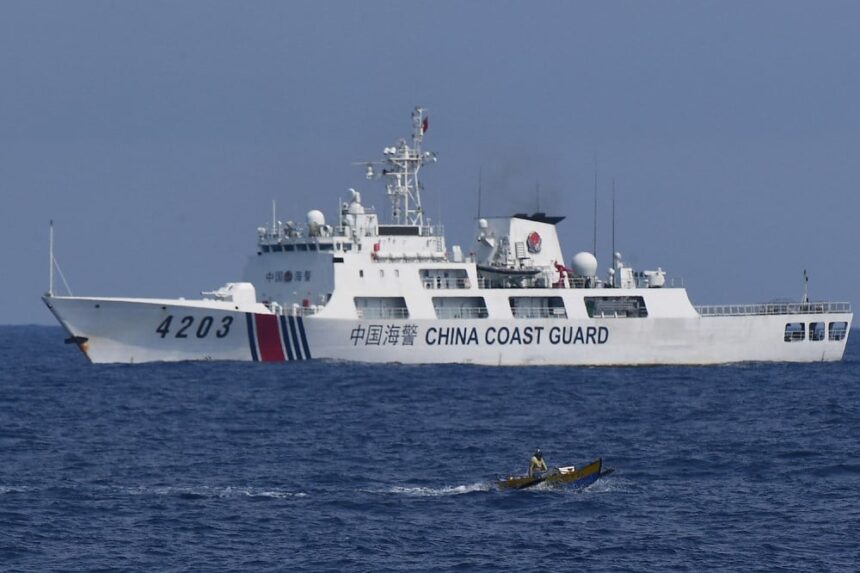Summary by Geopolist | Istanbul Center for Geopolitics:
The article discusses the ongoing maritime conflict between the Philippines and China in the South China Sea, particularly focusing on the increasing tensions at the Scarborough Shoal. Despite attempts at diplomatic resolutions, the situation remains volatile, with both nations asserting their claims over the region. Chinese coast guard vessels have been frequently seen patrolling near the shoal, often leading to confrontations with Filipino fishermen and vessels.
The Philippines has attempted to bolster its presence and assert its territorial claims by increasing patrols and engaging in joint exercises with allies such as the United States. However, these measures have so far failed to deter China’s assertive maneuvers. The strategic importance of the South China Sea, which is rich in resources and a critical maritime route, further complicates the situation.
Efforts to establish a Code of Conduct between ASEAN and China have been ongoing, aiming to manage the maritime disputes and reduce the risk of conflict escalation. Nonetheless, progress has been slow, and the geopolitical rivalry between China and the U.S. adds another layer of complexity to the issue.
Key Points:
-
Escalation of Aggression:
- China has significantly intensified its harassment of other nations in the South China Sea, particularly targeting the Philippines.
- Aggressive actions include chasing away fishing vessels, attacking ships with water cannons, and swarming other countries’ vessels with Chinese coast guard and navy ships.
-
Recent Developments:
- Since spring 2024, China has increased efforts to interfere with Philippine vessels in their own exclusive economic zone.
- Over 100 Chinese coast guard and maritime militia vessels have continuously interfered with resupply missions to the Philippine outpost at Second Thomas Shoal.
- Recently, the number of Chinese navy ships in the area doubled, expanding harassment to include military exercises around Sabina Shoal, closer to the Philippines.
-
Tactics and Incidents:
- In late May, Chinese sailors stole airdropped food supplies intended for Philippine marines aboard the Sierra Madre.
- China also interfered with a medical evacuation from the grounded ship.
- These actions are described as part of a broader toolkit of measures aimed at harassing the Philippines short of outright force.
-
Geopolitical Context:
- The South China Sea is crucial for global shipping lanes and is rich in undersea oil and gas.
- China claims nearly the entire sea based on historical grounds using its “nine-dash line” map, conflicting with territorial claims by the Philippines, Vietnam, Malaysia, and Indonesia.
- China’s actions are not only driven by a desire for resources but also for geostrategic control and asserting sovereignty as part of the “China Dream” articulated by President Xi Jinping.
-
International Response:
- The Philippines, backed by a mutual defense treaty with the United States, has become more assertive under President Ferdinand Marcos Jr.
- Manila frequently cites a 2016 arbitration ruling from The Hague affirming its territorial rights.
- Other regional players, such as Vietnam, Malaysia, and Indonesia, continue their offshore drilling projects despite Chinese interference and have strengthened maritime security cooperation with the Philippines.
-
Potential for Conflict:
- The increasing pace of Chinese operations and belligerent rhetoric raise concerns of an accidental escalation into conflict.
- Experts suggest the South China Sea is a more likely trigger for conflict than Taiwan due to the lower ceiling of such a conflict and the immediate risks posed by repeated unsafe military maneuvers by Chinese vessels and aircraft.
-
Strategic Importance:
- Features like Second Thomas Shoal are seen as strategically valuable for maintaining control over the eastern flank of the South China Sea.
- The persistent aggression by China reflects a broader strategy to prevent Southeast Asian countries from exploiting regional energy resources and to solidify its claims.
-
China’s Long-term Strategy:
- China’s relentless pursuit of control in the South China Sea is driven by political legitimacy, nationalism, and strategic military objectives.
- Xi Jinping’s vision includes asserting China’s sovereignty over claimed territories, even if it leads to international condemnation and risks of conflict.
Conclusion:
China’s escalated harassment of the Philippines and other Southeast Asian nations in the South China Sea represents a strategic effort to assert control over a vital region rich in resources and crucial for global maritime trade. The situation remains tense, with significant risks of conflict due to China’s aggressive actions and the increasing assertiveness of the Philippines and its allies.
For more details, read the full article here below.
China has sharply ratcheted up its harassment of other nations in the South China Sea in recent days, with particular belligerence reserved for the Philippines.
While China’s aggressive behavior—including chasing away fishing vessels, attacking other ships with water cannons, and virtually smothering other countries’ vessels with a swarm of Chinese coast guard and navy vessels—has been going on for at least a decade, Beijing’s nonstop aggression in the South China Sea risks becoming a likelier flash point for conflict than even the brewing great-power contest over Taiwan.
Since this spring, and especially over the past week, China has intensified its efforts to harass and chase away Philippine vessels operating in their own exclusive economic zone. More than 100 Chinese coast guard ships and so-called maritime militia vessels have continuously interfered with resupply missions to a Philippine outpost at Second Thomas Shoal, a tiny feature about 105 nautical miles off the country’s western coast.
In just the past week, the number of Chinese navy ships on station nearby doubled, expanding their harassment campaign to include military exercises around another small atoll, Sabina Shoal, that is even closer to the Philippines (and where Manila suspects Beijing might be trying to build another artificial island). Chinese harassment campaigns further afield, targeting Vietnam, Indonesia, and Malaysia, continue apace, but not with the same intensity as that reserved for the Philippines.
What’s notable about the latest Chinese efforts is the lengths they seem prepared to go to interfere with routine Philippine operations. In late May, Chinese sailors in small craft resorted to stealing airdropped food supplies for Philippine marines aboard the Sierra Madre, a grounded vessel that Manila uses to physically assert its claim to Second Thomas. That same month, China also interfered with Philippine efforts to medically evacuate a marine from the grounded ship.
“With the Philippines, China is stretching the toolkit of measures—they are doing things they haven’t done to Vietnam or Malaysia,” said Collin Koh of the S. Rajaratnam School of International Studies in Singapore. “They are stretching the toolkit to everything short of force.”
The low-intensity battles for control of the South China Sea, one of the world’s most important shipping lanes and a promising source of undersea oil and gas, have been going on for years and really picked up pace last year. Beijing claims the entirety of the sea for itself on specious historic grounds, using its “nine-dash line” map and other artifices to lay title to tiny rocks and atolls hundreds of miles away from the Chinese mainland. Other nations, including the Philippines, Vietnam, Malaysia, and Indonesia, have their own robust territorial claims that rankle Beijing’s expansive visions. For a decade, for instance, China has tried to chase away Vietnamese drilling rigs seeking to operate in Vietnam’s own waters.
The reason China’s maritime harassment is becoming less background noise and more concerning now is not just because the pace of Chinese operations is ticking upward. So, too, is belligerent Chinese rhetoric—matched by growing Philippine resolve, backed by a decades-old defense treaty with Washington.
At the Shangri-La Dialogue security conference in Singapore over the weekend, China’s defense minister railed at what he saw as U.S. support for Taipei and Manila, warning that “we will not allow any country or any force to create conflict and chaos in our region.” Other Chinese generals decried the foreign “wolves” trying to interfere in their backyard.
Philippine President Ferdinand Marcos Jr. told the same conference that the Philippines will defend its rights in the disputed waters, citing a landmark and binding 2016 arbitration ruling from The Hague, and he warned that any Chinese actions that lead to the death of a Filipino could trigger the mutual defense pact with the United States. Washington already affirmed, in the last two administrations, that any such event in the South China Sea would activate the mutual defense treaty.
That alone would be bad enough, but there is also the risk of accidental escalation from repeated unsafe military maneuvers by Chinese vessels and aircraft in recent years as they try to swat away U.S., allied, and third-country ships and planes in the region.
“I believe the South China Sea is a far more likely trigger than Taiwan,” said Gregory Poling, director of the Asia Maritime Transparency Initiative and a senior fellow at the Center for Strategic and International Studies. “The ceiling of any such conflict is lower” than any fight over Taiwan, he said, and wouldn’t go nuclear. On the other hand, it wouldn’t necessarily be a long time building. “This is something we could wake up to,” he said.
But why is China expending so much energy, incurring so much international opprobrium, and risking outright conflict over what amounts to a handful of insignificant rocks?
For starters, there are plentiful energy resources all over the South China Sea, especially natural gas, above all in the southern part of the sea between Vietnam and Malaysia. That’s one reason countries such as Vietnam, Malaysia, and Indonesia have been actively exploring and drilling for energy throughout the region despite years of Chinese interference.
China is busy drilling in waters close to its own shores, but the ample resources that Vietnam and Malaysia are seeking to tap over Chinese objections are of little use to China, beyond the fact that they are well outside any waters it could legally lay claim to: The gas deposits are just too far away from China to be pumped or piped back to the mainland. But those energy riches are ripe for the picking for nearby neighbors, who want to tap the gas (and oil) to limit their dependence on imported energy.
“The energy resources matter, but only for countries in Southeast Asia,” Poling said. “China just doesn’t want them to have it.”
Koh pointed to another possible reason for China’s insistence: the geostrategic importance, in Beijing’s eyes, of those tiny features, especially those shoals close to the Philippines. China already has a hold on features farther west, in the Spratly and Paracel island groups, as well as nearby Mischief Reef. It’s the eastern flank that looks vulnerable, including the continued Philippine presence at Second Thomas, which is supported by Philippine control of nearby Sabina Shoal.
“There are not many key strategic possessions that you can hold that have value” in that part of the South China Sea, Koh said. “Second Thomas Shoal has some important value.”
But ultimately, China’s dead set on grabbing every last feature in the broad swath of sea it claims because that is what Chinese President Xi Jinping has repeatedly vowed to do. Since he took office, he has stressed the importance of China asserting its “sovereignty” over all the areas that it claims are Chinese, regardless of those claims’ lack of support in international and maritime law. Xi beefed up the world’s biggest coast guard and gave it teeth, and belied his own promises not to militarize the South China Sea by using land reclamation to turn tiny spits of sand into military bases.
“Xi does it for political legitimacy and nationalism,” Poling said. “He put all this in the first ‘China Dream’ speech in 2013. He overhauled the Chinese coast guard and greenlit the island construction. The reason they cannot give an inch is because it is as much a part of the ‘China Dream’ as the Belt and Road or reunification with Taiwan.”
The problem for Beijing is that its tactics aren’t working. The Philippines has only become more assertive, especially under Marcos, who reversed early efforts at Philippine appeasement of China by his predecessor. That assertiveness is both practical, including closer defense ties and commitments with the United States, and rhetorical, including frequent invocations of the Philippines’ binding legal victory over China regarding the South China Sea disputes. That reminder to China of its stinging legal rebuke has driven Beijing, after years of virtually ignoring the 2016 decision, to attempt to undermine it, in the process reminding everyone that the Philippines has international law on its side.
China’s other targets haven’t backed down, either. Vietnam, Malaysia, and Indonesia are all plunging ahead with ambitious offshore oil and gas projects. All three countries have intensified maritime security cooperation with the Philippines to manage potential clashes in the region. The famously slow-to-condemn-China grouping at the Association of Southeast Asian Nations finally weighed in on the worsening security situation late last year.
“China is stuck doing the same thing over and over every month,” Poling said. “All they are really doing is creating this anti-China coalition.”
By Keith Johnson
Source: Foreign Policy







